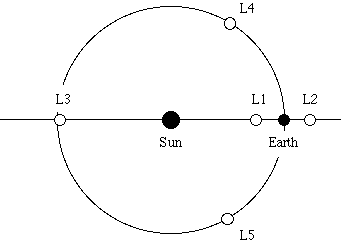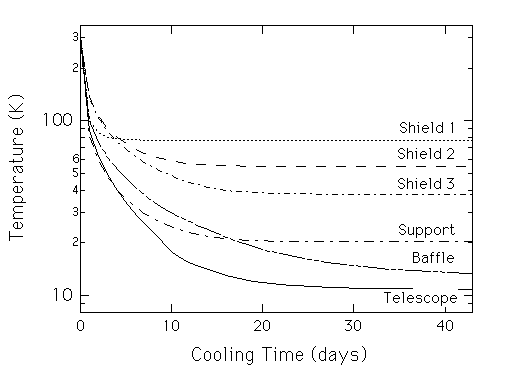HII/L2 Mission
2.2 Sun-Earth Lagrangian liberation point L2
First, we propose one of the
five Sun-Earth Lagrangian liberation points (L2)
as an orbit for an observatory-type infrared mission.

Figure 1: Sun-Earth Lagrangian liberation points.
Figure 1 shows the five Lagrangian liberation points
of the Sun-Earth system. The nearest points to the earth
among them are L1 and L2 points, which are about  km from the earth. They are on a straight line connecting
the sun and the earth, and are thus metastable.
But it requires a very small
km from the earth. They are on a straight line connecting
the sun and the earth, and are thus metastable.
But it requires a very small  (several m s-1 year-1)
to keep a satellite in orbit around them10.
(several m s-1 year-1)
to keep a satellite in orbit around them10.
Among them, L2 (hereafter S-E L2;
the point at the opposite side of the sun from the earth)
is the best place for infrared astronomy
for the following reasons:
- Effective cooling by radiation
The apparent size of the earth, which is one of the dominant
heat source for satellites near the earth, becomes small (  30'),
and all of
the heat sources (Sun, Earth, Moon) are almost in the same direction.
Hence, it is very easy to shield the telescope from the heat
sources, and the radiative cooling
becomes very efficient. Our simple estimate (Figure 2)
shows that, if the telescope is properly shielded from the solar radiation,
the temperature of the telescope can be cooled as low as
20 K only by the radiative cooling.
30'),
and all of
the heat sources (Sun, Earth, Moon) are almost in the same direction.
Hence, it is very easy to shield the telescope from the heat
sources, and the radiative cooling
becomes very efficient. Our simple estimate (Figure 2)
shows that, if the telescope is properly shielded from the solar radiation,
the temperature of the telescope can be cooled as low as
20 K only by the radiative cooling.
- Long integration time
Since the sun and the earth are in almost the same
direction, large areas of the sky can be observed. With the
help of a stable gravitational
condition at the S-E L2, very long integration
is possible.

Figure 2: Temperature profile of a model payload
with an effective shielding system.
It is cooled only by radiation.
Therefore, we conclude that S-E L2 is the best orbit for
observatory-type infrared missions.



Previous: 2.1 Orbits of Previous
Up: 2 ORBIT
Next: 2.3 Technical Feasibility
Apri 18, 1998
admin @ ir.isas.jaxa.jp


![]() km from the earth. They are on a straight line connecting
the sun and the earth, and are thus metastable.
But it requires a very small
km from the earth. They are on a straight line connecting
the sun and the earth, and are thus metastable.
But it requires a very small ![]() (several m s-1 year-1)
to keep a satellite in orbit around them10.
(several m s-1 year-1)
to keep a satellite in orbit around them10.
